ICS Learn

Online Learning vs. Classroom Learning

04 July 2019 - 3 min read
As online learning providers, we’re often asked about the key differences between online learning and the traditional classroom environment.
If you’re wondering if this mode of study would be right for you or your colleagues, then we’re here to help.
We’re taking a deep dive into the academic research in this area, to give you a full overview of the differences between these types of learning and how the method of study impacts the outcome.

Educational Outcomes
In a study that examined the differences between online and traditional learning formats, 88% of those surveyed reported that they chose online learning to fit around other commitments. This is to be expected, as it’s much easier to fit a flexible course into a busy schedule than a rigid, classroom-based format.
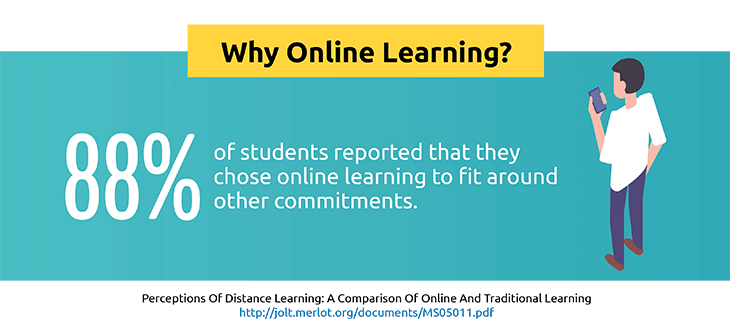
Flexibility not only impacted the choice of course, as in this study those engaged in online learning reported that their grades were higher. 59% of these students had higher grades when studying online, compared to their results when studying in a classroom environment.
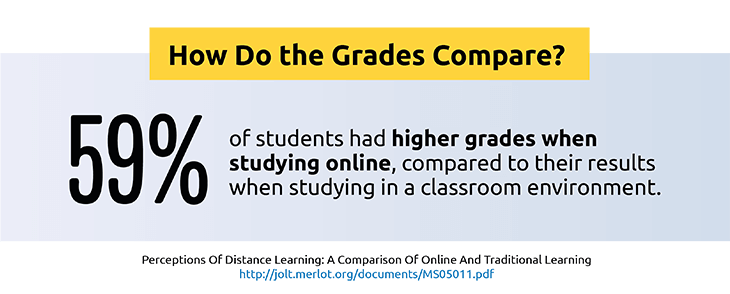
According to the same study, students’ mean time spent on courses was 2 hours higher per week when learning online. This can be attributed to a number of factors, including the lack of travel time to a classroom, the ability to fit extra studies in and increased motivation.
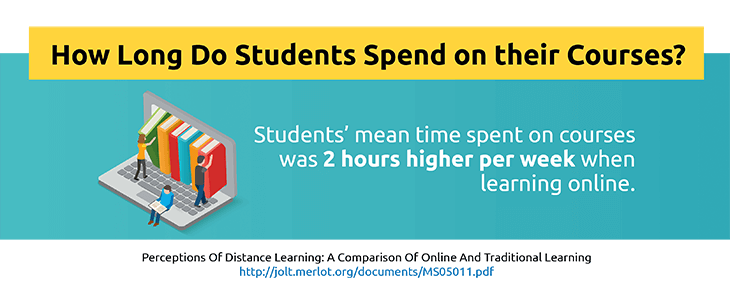
This is particularly important for workplace learning, as employees can struggle to fit this learning around their schedule. With free time already short for these employees, online learning offers much-needed flexibility when compared to classroom learning.
Other studies have noted some students feel like online learning takes a longer time to reach the same competency when compared to the traditional classroom. In the summary of “Comparing the Perceptions of Online Learning between Students with Experience and Those New to Online Learning”, the researchers suggest:
“… [the tutor] can remind students of the fact that they will not incur the commuting and seat time required for a traditional class, and that they can then allocate this “saved” time for meeting online course expectations.”
This shift in attitude and perception can be exactly what the learner needs to invest the time in their studies.
Student Investment in Learning
There is also evidence to suggest that online learning facilitates a higher level of effort from the student. They must self-direct their learning, which can represent a better level of investment from the student in their own success.
Motivational tools like online announcements, discussions with other students and multimedia materials also contributed to their investment in studying.
Other studies have suggested that learning at their own pace also allows the student to gain a deeper understanding of the course content. They can revisit these materials at their leisure and this allows them to study the concept until they understand it, rather than attempting to keep up with the rest of a classroom.
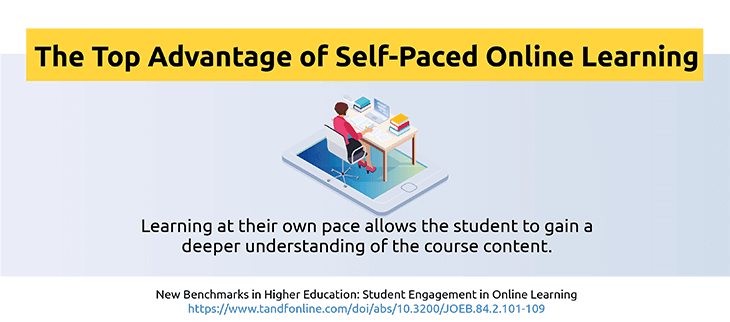
The Learning Experience
A comprehensive virtual learning environment that allows for interaction from the student has the potential to engage students further. The quality of the learning environment has a factor to play, as studies show that a carefully designed interface can significantly improve the learning experience.
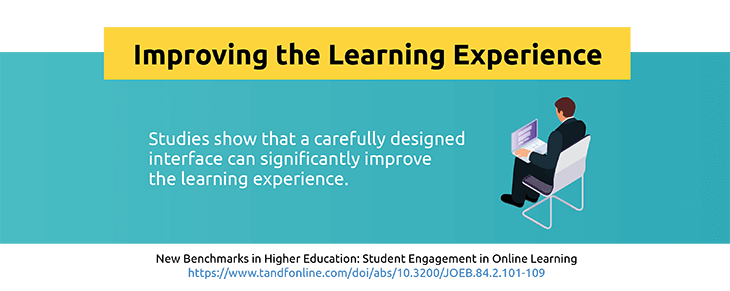
Some students prefer the nature of classroom learning as it promotes discussion between learners. However, this can be replicated online to give a similar experience to the student, while still offering them the convenience that they want.
Creating online debate teams and using this as part of the learning experience builds community and interaction with students. In fact, research suggests that shyer students or those with cultural differences can find it easier to interact in this way rather than online.
Research suggests that these activities that require real engagement from students improve their learning experience. Through active discussions, tasks and debates with others, these students can feel more engaged with the course content. One researcher describes the role of learning providers to add ‘the spark’ which makes for a more enjoyable and interesting online learning experience.
The most successful online learning strategies have multiple elements. This ‘blended’ approach tends to be more popular and garner better results with students.
By using video lectures, mock examinations, tutor support and other elements – the basic text is augmented. Learners are more aligned with this style of learning and will invest themselves further in the lessons therein. If the content is solely text-based, some learners will become disengaged and struggle to complete their education.
Similar issues can also occur in the classroom too, as the teaching style may not work for every student. Too much of one style of delivery, like purely audio delivery in the classroom, can also impact the uptake of this information.

Overcoming Barriers to Learning
There are still barriers to accessing learning online, such as technical skills and learner motivation. However, studies have explored solutions to these barriers.
For example, an issue with technical skills can be overcome using tutorials and further engagement with students. By creating an instructional environment, learners don’t require a high technical knowledge to access the course.
The use of different elements can also speak to different kinds of learners, with video, audio and written information. Creating a positive culture towards the learning environment is also important, as this helps to overcome many barriers, including dissatisfaction, reluctance to attempt learning and other attitude-related issues.
This is an issue that is not solely confined to online learning, as the learner’s attitude comes into play in all types of learning. However, the solutions offered will change depending on the mode of learning. Offering support virtually may not be as effective for all learners as meeting with a tutor in person.
In studies that have examined the acceptance of online learning, new learners report more difficulties than those that have studied online previously. Simply familiarising themselves with processes and viewing helpful materials, like online orientation videos, can drastically reduce any issues with this uptake.
Part of the success of the learner comes down to their own perception of the learning process. In a study examining learning in a corporate setting, it was found that those who felt more in control and less influenced by outside events were more likely to succeed in online learning.
When studying attrition levels of online learners, those who were more confident in their abilities were able to deal with the cognitive load at the start of the course and push through any adjustment period.
This initial adjustment period can be daunting to a learner, especially with self-directed study. This is where an enhanced onboarding process can also give way to better outcomes for the learner.

Key Points
We’ve discussed a lot of information through the course of this article, so let’s boil it down to some key points for you to consider.
Overall, we found that the individual learner is the biggest contributor to success with online learning. Those who use the materials to their advantage and self-direct their studies with purpose can excel to gain better marks when compared to those in the classroom.
Unsurprisingly, convenience was the most commonly cited reason for accessing online learning instead of a traditional classroom environment.
It’s not inherently more difficult for learners to uptake information online; in fact, for many this can be a useful tool. While there are barriers to online learning, such as learner motivation, similar barriers also apply within the classroom environment.
The right learning materials also have a part to play in student success. A blended multimedia approach allows the learner to fully engage with the materials and reach a better understanding. Their ability to repeatedly access this content until they understand it completely can also help to raise their scores further.
With the correct attitudes and support, online learning offers better results for the majority of students than traditional classroom learning - with the additional benefit of convenience and flexibility.
Find out more about how our online qualifications can assist you in flexibly upskilling your staff.












